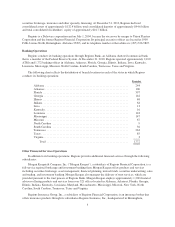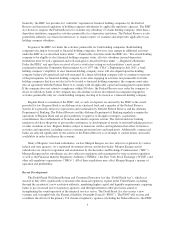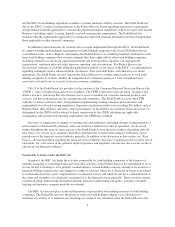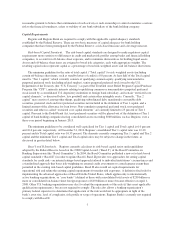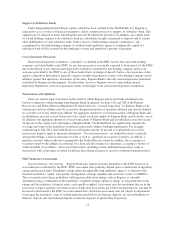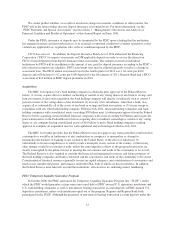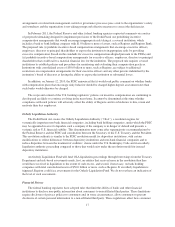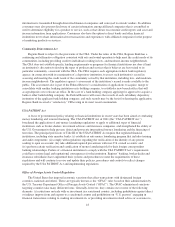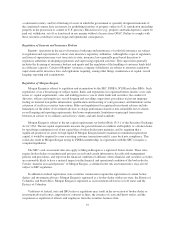Regions Bank 2010 Annual Report Download - page 23
Download and view the complete annual report
Please find page 23 of the 2010 Regions Bank annual report below. You can navigate through the pages in the report by either clicking on the pages listed below, or by using the keyword search tool below to find specific information within the annual report.• provides for a “countercyclical capital buffer”, generally to be imposed when national regulators
determine that excess aggregate credit growth becomes associated with a buildup of systemic risk, that
would be a CET1 add-on to the capital conservation buffer in the range of 0 percent to 2.5 percent
when fully implemented (potentially resulting in total buffers of between 2.5 percent and 5 percent).
The capital conservation buffer is designed to absorb losses during periods of economic stress. Banking
institutions with a ratio of CET1 to risk-weighted assets above the minimum but below the conservation buffer
(or below the combined capital conservation buffer and countercyclical capital buffer, when the latter is applied)
will face constraints on dividends, equity repurchases and compensation based on the amount of the shortfall.
The implementation of the Basel III final framework will commence January 1, 2013. On that date, banking
institutions will be required to meet the following minimum capital ratios:
• 3.5 percent CET1 to risk-weighted assets;
• 4.5 percent Tier 1 capital to risk-weighted assets; and
• 8.0 percent Total capital to risk-weighted assets.
The Basel III final framework provides for a number of new deductions from and adjustments to CET1.
These include, for example, the requirement that mortgage servicing rights, deferred tax assets and significant
investments in non-consolidated financial entities be deducted from CET1 to the extent that any one such
category exceeds 10 percent of CET1 or all such categories in the aggregate exceed 15 percent of CET1.
Implementation of the deductions and other adjustments to CET1 will begin on January 1, 2014 and will be
phased-in over a five-year period (20 percent per year). The implementation of the capital conservation buffer
will begin on January 1, 2016 at 0.625 percent and be phased in over a four-year period (increasing by that
amount on each subsequent January 1, until it reaches 2.5 percent on January 1, 2019).
The U.S. banking agencies have indicated informally that they expect to propose regulations implementing
Basel III in mid-2011 with final adoption of implementing regulations in mid-2012. Notwithstanding its release
of the Basel III framework as a final framework, the Basel Committee is considering further amendments to
Basel III, including the imposition of additional capital surcharges on globally systemically important financial
institutions. In addition to Basel III, the Dodd-Frank Act requires or permits the Federal banking agencies to
adopt regulations affecting banking institutions’ capital requirements in a number of respects, including
potentially more stringent capital requirements for systemically important financial institutions. Accordingly, the
regulations ultimately applicable to us may be substantially different from the Basel III final framework as
published in December 2010.
The Dodd-Frank Act appears to require the Federal Reserve to adopt regulations imposing a continuing
“floor” of the Basel I-based capital requirements in cases where the Basel II-based capital requirements and any
changes in capital regulations resulting from Basel III otherwise would permit lower requirements. In December
2010, the Federal Reserve published for comment proposed regulations implementing this requirement.
Liquidity Requirements. Historically, regulation and monitoring of bank and bank holding company
liquidity has been addressed as a supervisory matter, both in the U.S. and internationally, without required
formulaic measures. The Basel III final framework requires banks and bank holding companies to measure their
liquidity against specific liquidity tests that, although similar in some respects to liquidity measures historically
applied by banks and regulators for management and supervisory purposes, going forward will be required by
regulation. One test, referred to as the liquidity coverage ratio (“LCR”), is designed to ensure that the banking
entity maintains an adequate level of unencumbered high-quality liquid assets equal to the entity’s expected net
cash outflow for a 30-day time horizon (or, if greater, 25 percent of its expected total cash outflow) under an
acute liquidity stress scenario. The other, referred to as the net stable funding ratio (“NSFR”), is designed to
promote more medium- and long-term funding of the assets and activities of banking entities over a one-year
time horizon. These requirements will incent banking entities to increase their holdings of U.S. Treasury
9






